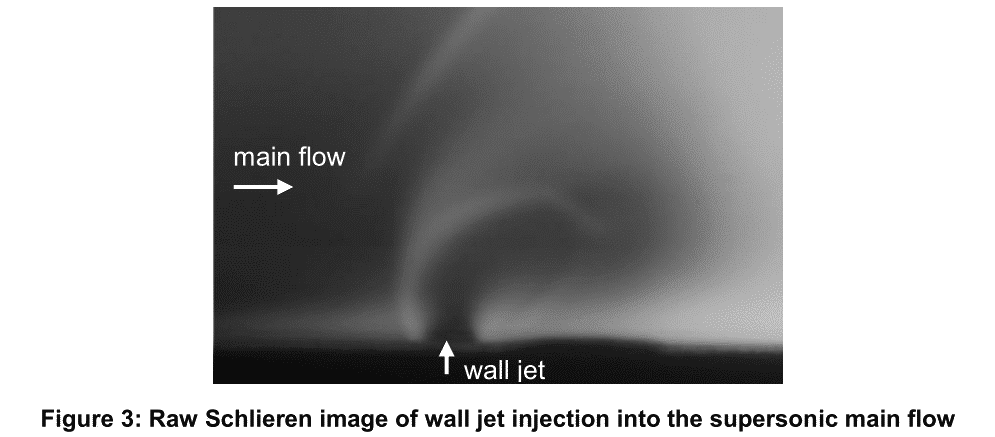Schlieren imagining is an often used technique to visualize shock and expansion waves in supersonic flows. While the conventional setup is sensitive to the entire light path between the imaging optics, the focusing Schlieren setup allows the investigation of a plane normal to the optical axis due to its narrow depth of focus [1, 2, 3].
In this paper, we present and analyze the performance of a focusing Schlieren setup as illustrated in Figure 1. The design of the system was driven by its future application in the supersonic combustion test facility at the Institute of Aerospace Thermodynamics (ITLR).

The test facility allows long duration, high temperature combustion experiments, while optical access to the flow field inside the combustion chamber investigated is obtained via quartz windows. While the centers of the windows are exposed to the hot gas flow, their peripheries are part of the cooled channel wall. Hence, the windows are subject to large thermal gradients, which change the refraction index locally and render the use of a conventional Schlieren setup impossible. A focusing Schlieren setup, however, is expected to overcome these thermal distortions.
The presented setup uses off the shelf optics together with a high power LED instead of a pulsed laser source, which is normally used in situations where high luminance is required [4]. For validation of the setup, a reference free jet is investigated. For this purpose, pressurized air is expanded through a small tube with an inner diameter of 1 mm, which generates a small and locally defined shock system.
The jet is mounted traversable along the optical axis to experimentally determine the depth of focus. Figure 2 demonstrates this procedure. The first image shows the case where the jet is in the object plane of the Schlieren system (x=0 mm) and hence displayed sharp. The jet is then subsequently shifted out of the object plane along the optical axis by 20 mm and 40 mm, respectively, resulting in more and more blurred images.

The full paper will contain a complete validation of a low cost, easy to use Schlieren setup using this free jet as well as an assessment of the influence of the combustion chamber windows on the light path. Thereby the functionality of the setup under realistic experimental conditions will be verified by the application to the supersonic combustion chamber at ITLR. Figure 3 shows preliminary Schlieren image of the flow field with a wall injection inside the combustion chamber. Here the main flow Mach number equals 2 at a flow total temperature of 1250 K, while the air jet is injected transonically at a total temperature of 300 K.

[1] Weinstein, L., “Large-Field High-Brightness Focusing Schlieren System”, AIAA Journal, Vol. 31, No. 7, 1993, pp. 1250-1255
[2] Weinstein, L., “Review and Update of Lens and Grid Schlieren and Motion Camera Schlieren”, Eur. Phys. J. Special Topics, Vol. 182, 2010, pp. 65-95
[3] Settles, G., “Schlieren and Shadowgraph Techniques”, 2nd ed., Springer Verlag, 2006
[4] Kouchi, T. et al.: “Focusing-Schlieren Visualization in Direct-connect Dual-mode Scramjet”, 18th AIAA/3AF International Space Planes and Hypersonic Systems and Technologies Conference, 2012, AIAA 2012-5834

